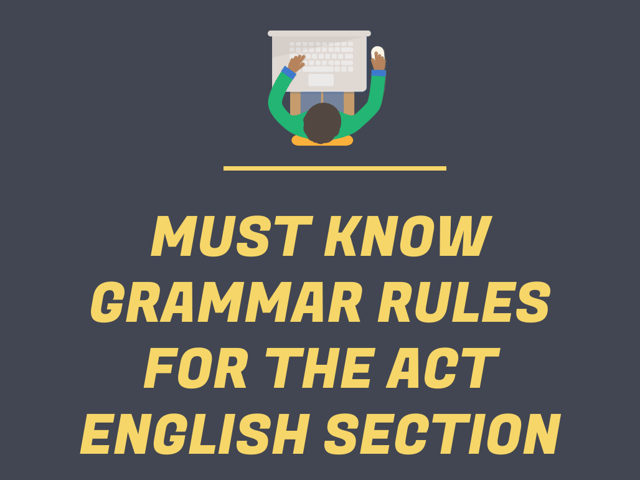
Must-Know Grammar Rules for the ACT English Section
Although the conventions of standard English appear innumerable, they originate from several basic rules that form the foundation for more sophisticated structure and language. These grammatical guidelines comprise sentence structure and formation, punctuation, and word usage.
Sentence Structure
The eight parts of speech—noun, pronoun, verb, adjective, adverb, preposition, conjunction, and interjection—are the basis for structuring a sentence. Additionally, within any sentence, the parts of speech serve a variety of purposes—subject, object, indirect object, predicate, complement, article, or modifier. Not every sentence will contain all the parts of speech, but every sentence must have a part of speech acting as the subject and another as the predicate. To illustrate:
“Leslie and Gina have planned a shopping trip this weekend.”
-
The proper nouns “Leslie” and “Gina” are the subjects in the sentence (whom the sentence is about) and “have planned” are the helping verb and action verb serving as the predicate (the section of the sentence that tells about the subject).
-
This example also contains the conjunction and, which joins the compound subject; the article a; the object shopping trip constructed with the adjective shopping and noun trip; as well as the pronoun this and noun weekend, which act as a modifier, indicating when the trip will take place.
Know the parts of speech and how they can work together in a sentence, and you’ll have discovered the foundation for sentence structure.
Sentence Formation
With these foundational components, you can then create different types of sentences:
- simple— one subject and predicate
- compound— two or more subject/predicate clauses within one sentence
- complex— one subject and predicate along with at least one dependent clause acting as a modifier
All sentences must be independent clauses, clauses that have a subject and predicate. To include more information within one sentence, you can add dependent clauses. These clauses also have a subject and predicate, but they cannot stand alone as a complete sentence. Instead, they modify the main subject and predicate, answering such questions as where and why. For example:
“While I was watching the evening news, a storm warning appeared on the television screen.”
The independent clause in this sentence is, “a storm warning appeared on the television screen.” The dependent clause, “While I was watching the evening news,” explains when the warning appeared.
Punctuation
When you have determined what parts of speech will best communicate your point and you have decided how simple or complex the sentence will be, you must decide which punctuation marks are necessary to complete the structure. End punctuation marks include: *
- a period for a declaration
- a question mark for an inquiry
- an exclamation point for an emotionally charged point
Punctuation marks within the sentence further define the sentence type. That is, when you create a compound sentence using one of the coordinating conjunctions like and or but, you must include a comma in front of the conjunction. It is the comma plus the conjunction that indicate the sentence is made up of two independent clauses. Commas serve other purposes within a sentence such as to set off introductory material and to separate items in a list.
The semicolon, colon, apostrophe, parentheses, and quotation marks are several of the remaining punctuation choices. Each has a distinct purpose worth reviewing so that as you write, you know your options for both parts of speech and punctuation to articulate your message in clear and rhetorically effective ways.
Word Usage
One final consideration is word usage. That is, know your spelling rules and their exceptions or routinely use a credible reference source when in doubt about a word’s spelling or the correct use of a word. Correct usage often involves the following:
homographs—words that are spelled alike but hold different meanings, (e.g., bass meaning low sound or bass meaning a type of fish)
homophones—words that are spelled differently but sound alike, (e.g., two meaning the number, to, the preposition, or too meaning also or in excess).
Putting It All Together
When building sentences, you can start small, such as:
“I understand.”
With thought and practice, that short, simple sentence can grow into a longer, complex one that provides your readers with exactly what you want them to see and understand. That abbreviated thought could become:
“With practice and patience, I understand increasingly more challenging material; such knowledge enables me to speak confidently and to share that comprehension with others.”

Keep Reading

ACT Blog
Essay Writing Practice and Prompts for the ACT
The ACT writing test is an optional exam, and is not always given as pa…

ACT Blog
How to Do Well on the ACT Essay
Understanding the ACT Essay Before diving into strategies to excel, it…

ACT Blog
How to Study for the ACT in One Week
Getting ready for American College Testing (the ACT) can be a source of…